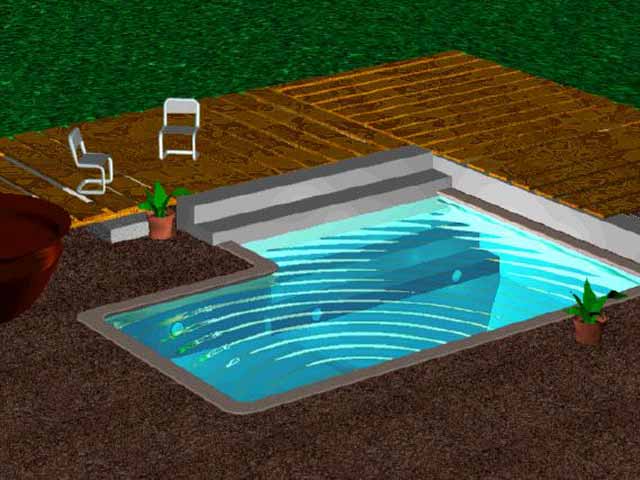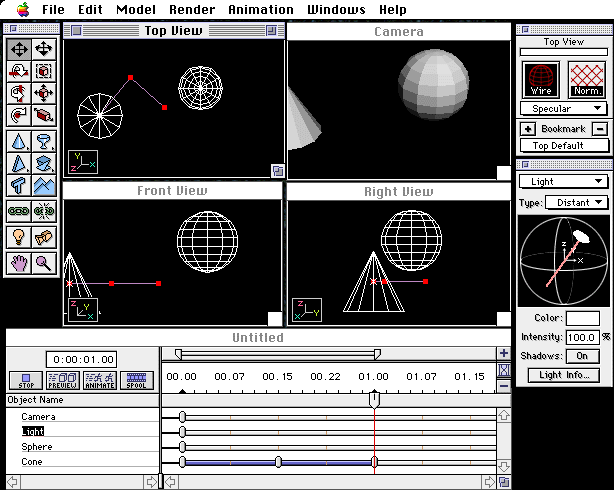For April, the TurboSquid home page is featuring not one, but two CheckMate Pro models, a combination of complementary assets including a sexy and super fast looking Yamaha R6 motorcycle 3D model by Jamie Hamel Smith, with an equally stylish rider by 3D artist Vespa.
We got to chat with the man behind the motorcycle on how he got his start in the modeling field, where he finds his inspiration and how he got so good at making motorcycles.
When did you first realize you wanted to be a 3D artist?

Early 3D Pool Renders for Dad
My dad got us a Macintosh in 1997 (a Performa 6300CD) it was the first color computer I was ever exposed to and I started to play around on it. Eventually, my dad’s friend needed some help visualizing a 3D logo for a local TV spot he was producing. He got me some software called Specular Infini-D (the spiritual predecessor to Carrara and the only half-decent 3D software on the Mac at the time) and I gave it a shot. Turns out I liked it [3D], so I kept doodling on the Mac.
Later on my dad needed some help upgrading his “napkin sketches”. He’s a swimming pool maintenance / repairman / consultant and wanted a better drawing of a pool that he was consulting on. He asked if it was possible to do something in 3D if he gave me the dimensions and sketches, so I tried that and it was fun.
After a few pool renderings, my dad took me to a local studio to meet the guys and show them my work. They were not impressed and even though I asked to intern with them over the summer they basically gave me the “sorry kid” response. (I would have swept the floors or even got them drinks, I didn’t care what the job was; I just wanted to be exposed to their skills). After that, I kept doing 3D in my spare time and helping my dad out with menial graphics work.
I eventually graduated high school and decided that I wanted to do 3D as a career. My dad mentioned that there was another studio in town. I basically knocked on their door, portfolio & Zip disks in hand and asked for a job… strangely enough I was hired!
My full time job is now building web apps in HTML/JavaScript and PHP, but I’ve continued 3D modeling as a hobby, and to fund my “gadget lust”.
How did you come to start modeling motorcycles?
I’ve loved motorcycles since the day I was born. My dad rode motorcycles, my mom rode on the back of his bike before I was born, and I got my first bike at seven years old. The short answer is: Bikes are a niche that I have intimate knowledge of. My first dirt bike was a Yamaha 80cc mini-bike and I rode it until I was about 11. When I wasn’t riding it, I was staring at it wishing it wasn’t nighttime, or raining, or 6am 🙂 . My first street-legal bike was an old, decrepit Yamaha dirt bike that I had to fix and tune constantly. My second was a super-sport Honda CBR that I bought from my dad. My third was a 2001 Kawasaki Ninja, fresh off the showroom floor. When I wasn’t riding my bikes, I was taking them apart, repairing, tweaking, tuning, upgrading, and polishing them.
After creating a couple (crude by today’s standards) models and posting them on TurboSquid, a gentleman from the U.K. contacted me and asked that I model several bikes for a project he was working on. The money was good, I didn’t get bored and it was fun. At that point I decided that modeling bikes was “my thing”.
I never built any physical models of bikes, but I did start with a huge map of how the parts fit together in real life. I had the advantage of having held several parts of my bike in my hands. I knew how heavy and thick a brake caliper was. I remembered the diameter of the crank-case’s breather hose. Basically, it was an easy thing for me to start modeling because I was living it and constantly holding, repairing and replacing the parts involved. It helps when modeling something if you’ve held it a few inches from your face… to see it that close up. Maybe that’s why most people’s first 3D model is a wine glass or a coffee cup.
Looking at specifications and reference material online is key. Most of the bikes I modeled, I’ve never seen in real-life. I would not be able to model 90% of these bikes without the internet.
What is the primary software you use?
I use Cinema 4D at the moment. There are a few main reasons why I currently use it:
- Relatively inexpensive, especially with the MSA.
- Very visual and it has a manageable learning curve.
- Excellent renderer with a quick and visual approach to iterative changes.
- Relatively competitive features.
The reason I first tried Cinema 4D has to do with my past as an Apple fanboy. (I no longer have an allegiance to any operating system or computer manufacturer, but in 2001 I did.) I was testing the public beta of MacOS X on my iMac at the time, and Cinema 4D was the only 3D software available. I tried it out and my Infini-D skills transitioned over quite nicely. Cinema 4D was also 10,000 times as powerful as Inifni-D so I was sold.
I was exposed to Softimage (a few of my acquaintances used it) but did not like the lack of a friendly UI – to this day I still can’t figure it out. I have basic training in Maya (I took a few semesters of it at design school) and while I’d say that Maya is more powerful, Cinema 4D is much more practical for a small team or individuals.
The studio I worked at out of high school also adopted Cinema 4D shortly after I mentioned and demoed it to them.
You have some great textures on your models. Any tips?
Make it dirty! 3D’s curse is that it’s too clean. Round the edges so they look worn. Paint dark areas (occlusion) so they look like dirt has collected there and if possible, use some grunge textures to sell the effect. I don’t make things dirty enough, but every so often I am caught taking my own advice: https://www.turbosquid.com/3d-models/maya-air-compressor/253426
UV Mapping is key! It’s the only texture format that is fully interoperable. I think that any mapping on a model should be done with UV maps. You can push the limits really far as well. The PolyCount forum has an incredible showcase where users regularly post their UV textures for all to see. It’s amazing what you can pack into a UV map if you put the time in.
Thanks so much, Jamie! A lifelong love of motorcycles, hands on experience and serious persistence when it comes to modeling has definitely paid off. We’re really looking forward to your next CheckMate Pro submission!



